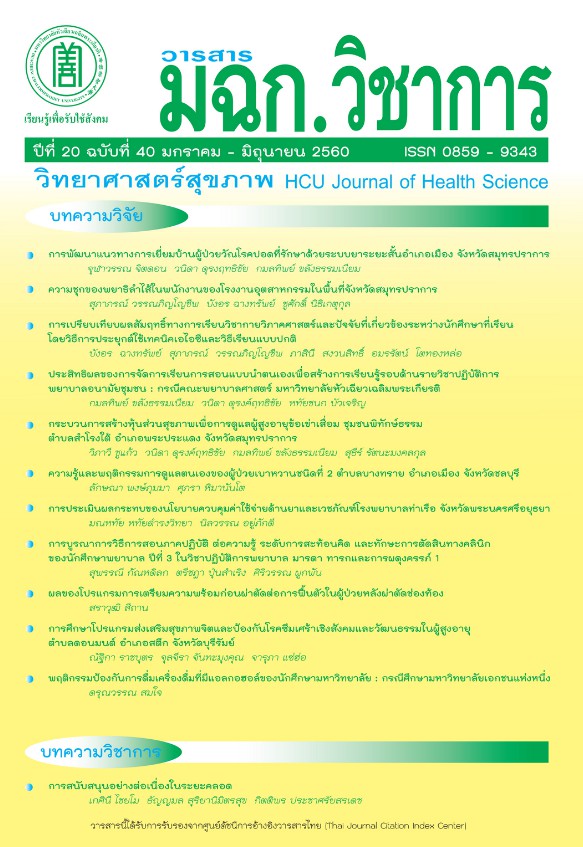The Integrated Clinical Teaching Methods on Reflective Thinking, and Clinical Judgment in 3rd Year Nursing Students in Maternal Infant and Midwife Nursing Practicum Course I
Keywords:
Case study, simulation based learning, post conference, reflective thinking, clinical judgmentAbstract
This study was a quasi-experimental research for- one group with a pretest and post-test design in clinical practice. This study aimed to compare between the pretest and the posttest of Maternal infant and midwifery nursing knowledge, reflective thinking and clinical judgment when applied nursing practice, case study, simulation based learning and post conference in Maternal infant and midwifery nursing practice. The participants were 106 third year nursing students at Boromrajonnani College of Nursing, Phraputthabat. They were assigned to practice at prenatal clinic, labor and delivery department, and postpartum ward for eight weeks. The instruments consisted of a multiple-choice test, reflective thinking questionnaire, and clinical judgment observational checklist. The content validity was qualified by experts and reliability of reflective thinking questionnaire was 0.78. The data were analyzed using descriptive statistics, paired t-test, and one sample t-test. The results showed that after nursing practice, case study, simulation based learning and post conference were applied, there were significant differences between pretest and posttest of knowledge and reflective thinking scores at .05 significance level. The Maternal infant and midwifery nursing knowledge score was significantly increased from 34.88 to 39.04, and the reflective thinking score was also significantly increased from 3.55 to 3.99. When reflective thinking subcategories were considered, there were significantly higher scores in habitual action, understanding, and self-reflection, while critical reflection has no difference. Clinical judgment score was significantly lower than 50 percent at .05 significance level. There were 64.4 percent of participants who were categorized in the lowest clinical judgment level, and 20.6 percent of them were indicated in the low clinical judgment level.
Downloads
References
Cirocco, MM. How reflective practice improves nurse’s critical thinking ability. J Gerontol Nurs. 2007;30(6):405-13.
Gustafsson C, Fagerberg I. Reflection, the way to professional development? J Clin Nurs. 2004;13:271–80.
Mann K, Gordon J, MacLeod A. Reflection and reflective practice in health professions education: a systematic review. Adv Health Sci Educ [Internet]. October
2009 [Cited 2015 November 20];14:595–621. DOI10.1007/s10459-007-9090-2.
Tanner CA. Thinking like a nurse: a research-based model of clinical judgment. J Nurs Educ. 2006;45(6):204-11.
Thompson C, Aitken L, Doran D, Dowding D. An agenda for clinical decision making and judgment in nursing research and education. Int J Nurs Stud. 2013;50:1720–6.
William W, Stephen GJ. Research methods in education: An introduction. 9th ed. Boston: Pearson; 2009.
Driscoll JJ. Practicing clinical supervision: A reflective approach for healthcare professionals. 2nd ed. London: Bailliere Tindall; 2007.
Jeffries PR. A framework for design, implement, and evaluation simulation used as teaching strategies in nursing. Nurs Educ Perspect. 2005;26(2):96-103.
Kember D, Leung DYP, Jones A, et al. Development of a questionnaire to measure the level of reflective thinking. Assess Eval High Educ. 2010;25(4):381-95.
Tayem YI. The impact of small group case-based learning on traditional pharmacology teaching. Sultan Qaboos Univ Med J. 2013;13:115-20.
Majeed F. Effectiveness of case-based teaching of physiology for nursing students. J Taibah Univ Sci. 2013;9(4): 289e-92e.
Chao SY, Liu HY, Wu MC, Clark MJ, Tan JY. Identifying critical thinking indicators and critical thinker attributes in nursing practice. J Res Nurs. 2013; 21: 204e-10e.
Li AM. Simulation-based clinical skill training to promote effective clinical learning with simulation evaluation rubrics in nursing education. Int J Inf Educ. 2016; 6(3): 237-42.
Yehle KS, Royal PA. Changing the post clinical conference: New time, new place, new methods equal success. Nurs Educ Perspect. 2010;31;256.
Cooper C, Taft LB, Thelen M. Examining the role of technology in learning: An evaluation of the clinical conferencing. J Prof Nurs. 2004;20:160-6.
Craft M. Reflective writing and nursing education. J Nurs Educ. 2005;44(2):53-7.
Benner P. From novice to expert, excellence and power in clinical nursing practice. Menlo Park, CA: Addison-Wesley Publishing Company; 1984.
Rhodes ML, Curran C. Use of the human patient simulator to teach clinical judgment skills in a baccalaureate nursing program. Comput Inform Nurs. 2005;23:256–62.
Downloads
Published
How to Cite
Issue
Section
License
บทความที่ได้รับการตีพิมพ์เป็นลิขสิทธิ์ของวารสารวิทยาศาสตร์สุขภาพและสุขภาวะ
ข้อความที่ปรากฏในบทความแต่ละเรื่องในวารสารวิชาการเล่มนี้เป็นความคิดเห็นส่วนตัวของผู้เขียนแต่ละท่านไม่เกี่ยวข้องกับมหาวิทยาลัยหัวเฉียวเฉลิมพระเกียรติ และคณาจารย์ท่านอื่นๆในมหาวิทยาลัยฯ แต่อย่างใด ความรับผิดชอบองค์ประกอบทั้งหมดของบทความแต่ละเรื่องเป็นของผู้เขียนแต่ละท่าน หากมีความผิดพลาดใดๆ ผู้เขียนแต่ละท่านจะรับผิดชอบบทความของตนเองแต่ผู้เดียว




